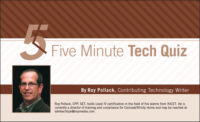1. Depleted batteries should be
a. discarded in the trash one by one so as to avoid a concentration of the battery acid in one spot.
b. recycled by an authorized and approved state recycling company.
c. gathered together at the office and then burned in a controlled fire, preferably in the company dumpster.
d. placed on a commercial vehicle charger to replenish the life of the battery since the alarm panel’s charging circuit cannot give it the extra charge needed for an effective recharge.
2. According to the National Electrical Code (NEC), the proper wire color for a grounding wire is
a. red.
b. black.
c. white.
d. green.
3. Rare-earth magnets are strong ___________ magnets made from alloys of rare earth elements.
a. permanent
b. temporary
c. but fragile
4. Today’s alarm systems are capable of performing home automation and can be used to help homeowners save energy.
a. True
b. False
5. The strongest type of magnet is the __________ type.
a. rare-earth
b. ferrite
c. alnico
d. cobalt
e. neodymium
6. The reference point in an electrical circuit from which other voltages are measured is referred to as the
a. ground potential.
b. grounding rod.
c. grounding electrode.
d. earth ground.
7. There is no accepted and proper battery disposal method other than covering the terminals to avoid a short and disposing in a garbage container.
a. True
b. False
8. The chemicals inside a battery are
a. lead and sulfuric acid.
b. lead and hydrogen peroxide.
c. sulfuric acid and ammonium nitrate.
d. hydrogen and lead acid.
9. Home automation can provide effective savings on a homeowner’s electric bill by controlling devices that utilize and could waste energy.
a. True
b. False
10. The proper measurement of an earth ground should not exceed
a. 5 ohms.
b. 15 ohms.
c. 25 ohms.
d. 45 ohms.
e. As long as the path is direct, the ohms measurement doesn’t matter.
11. Smoke detectors of the __________________ type are radioactive and must be disposed of properly.
a. photoelectric
b. ionization
c. metal oxide semiconductor
d. aspiration
12. White light can cause a false alarm on some motion detectors. White light passing through a prism breaks up the light. The color between yellow and blue in the spectrum is
a. red.
b. black.
c. green.
d. indigo.
13. The lightest metal and the least dense solid element is
a. carbon.
b. lead.
c. silver.
d. lithium.
14. Rechargeable batteries are good for the environment because
a. they use less natural resources during manufacturing.
b. there is less toxic waste associated with rechargeable batteries.
c. they do not use raw materials, they contain artificially made components.
d. They are not good for the environment because the electricity used to charge them utilizes more energy than the replacement of the battery.

|
What’s Wrong With This?
An alarm technician needed to connect two buildings together for his alarm system. He installed the wiring underground and buried it in the earth. He used cables listed for direct burial, but the local building inspector failed the installation. Can you tell what the alarm technician did wrong???

|




